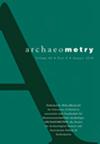Microbotanical analysis in artifacts of the CABUZA phase (900–1200 ce), Azapa Valley, northern Chile: Vessels and rites of “eating and drinking with the dead” in post-Tiwanaku times
IF 1.5
3区 地球科学
0 ARCHAEOLOGY
引用次数: 0
Abstract
We report observations of wear traces and microbotanical analysis of 29 ceramics, one pot of Cucurbita sp., and one wooden spoon—all artifacts of the AZ-6 and AZ-71 cemeteries of the Cabuza cultural phase (900–1200 ce), Azapa Valley, northern Chile—. The results show some unused artifacts (11) besides 21 samples that were positive for starches of Zea mays, Cucurbita sp., Manihot esculenta, Ipomoea batatas, or Phaseolus sp., in addition to vegetable remains (13 cases). This evidence is interpreted as an expression of funerary rites in post-state times, which could be an inheritance of the Andean Tiwanaku State (ca. 500–1000 ce).
智利北部阿扎帕山谷卡布扎阶段(公元前 900-1200 年)文物中的微生物分析:后提瓦纳库时代的容器和 "与死者同吃同喝 "仪式
我们报告了对智利北部阿萨帕山谷卡布萨文化阶段(公元前 900-1200 年)AZ-6 和 AZ-71 墓地出土的 29 件陶瓷器、一个葫芦罐和一个木勺的磨损痕迹观察和微生物分析结果。研究结果表明,除了 21 个样本对玉米、葫芦属、马尼荷属、红苕属或相思豆属淀粉呈阳性反应外,还有一些未使用过的人工制品(11 件),此外还有蔬菜残留物(13 件)。这一证据被解释为后国家时代丧葬仪式的一种表现形式,可能是对安第斯提瓦纳库国家(约公元前 500-1000 年)的继承。
本文章由计算机程序翻译,如有差异,请以英文原文为准。
求助全文
约1分钟内获得全文
求助全文
来源期刊

Archaeometry
地学-地球科学综合
CiteScore
3.60
自引率
12.50%
发文量
105
审稿时长
6 months
期刊介绍:
Archaeometry is an international research journal covering the application of the physical and biological sciences to archaeology, anthropology and art history. Topics covered include dating methods, artifact studies, mathematical methods, remote sensing techniques, conservation science, environmental reconstruction, biological anthropology and archaeological theory. Papers are expected to have a clear archaeological, anthropological or art historical context, be of the highest scientific standards, and to present data of international relevance.
The journal is published on behalf of the Research Laboratory for Archaeology and the History of Art, Oxford University, in association with Gesellschaft für Naturwissenschaftliche Archäologie, ARCHAEOMETRIE, the Society for Archaeological Sciences (SAS), and Associazione Italian di Archeometria.
 求助内容:
求助内容: 应助结果提醒方式:
应助结果提醒方式:


